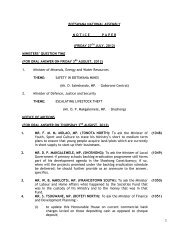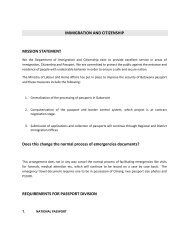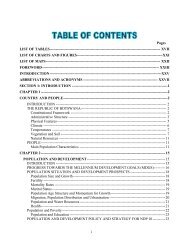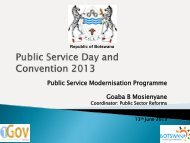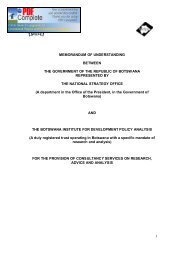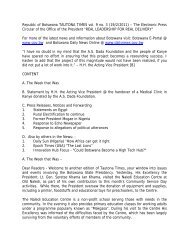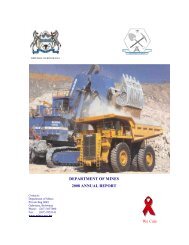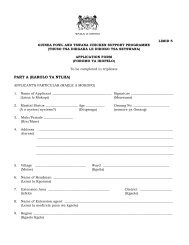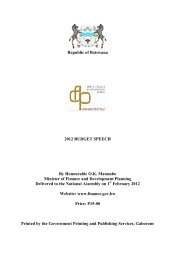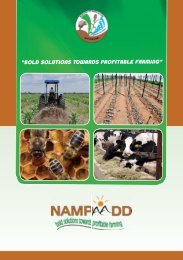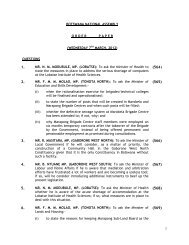Roads Department - Government of Botswana
Roads Department - Government of Botswana
Roads Department - Government of Botswana
You also want an ePaper? Increase the reach of your titles
YUMPU automatically turns print PDFs into web optimized ePapers that Google loves.
Appendices<br />
APPENDIX C<br />
RISK EVALUATION AND DETERMINATION OF REQUIRED<br />
PREVENTATIVE MEASURES-WORKED EXAMPLE<br />
<strong>Roads</strong> <strong>Department</strong><br />
INTRODUCTION<br />
This example follows the Procedure described in Chapters 4 and 5 <strong>of</strong> the guideline. There are two steps. First step is<br />
to establish whether the condition for salt damage exists. This is done by looking at the climatic and salt content data<br />
to obtain a risk rating. Step 2 involves determining the prevention measures required. The following hypothetical case<br />
is used for illustration.<br />
PROJECT DATA<br />
Project location: Village <strong>of</strong> Kang, Western <strong>Botswana</strong>.<br />
Road Construction: 150 mm subbase, 150 mm base. Assumed OMC: 10% moisture content.<br />
Surfacing: carriageway: Double surface treatment (trafficked)<br />
Shoulder: Single seal with sand cover seal (untrafficked).<br />
Climatic Conditions<br />
Regional climate: Semi-arid<br />
Annual mean temperature: 26°C<br />
Rainy season (precipitation): During Summer months<br />
Typical daily temperature range: Winter.......... 0 - 30°C - Range: 30<br />
Summer....... 15 - 42°C - Range: 27<br />
Salinity Conditions<br />
Sub-grade: non saline<br />
Calcrete Sub-base material: 0.4% TDS (or 2.25 E.C)<br />
Base Course material: 0.4% TDS (or 2.25 E.C)<br />
Compaction water: 5000 mg/l<br />
A- OBTAINING THE RISK RATING<br />
Stage 1:<br />
Obtaining M-Value<br />
From Fig. 4.2<br />
Read Pavement Materials Salinity on vertical axis (i.e. 0.4% TSS).<br />
Move horizontal to Brackish water (middle diagonal line) since the compaction water is brackish.<br />
Move downwards from this point to intercept M-Value.<br />
This is the Materials Risk Rating M-Value (M = 4)<br />
Stage 2:<br />
Obtaining Climatic Risk Rating<br />
From Table 4.1<br />
Since the Kang region is semiarid, select C 1<br />
value <strong>of</strong> 6, C 1<br />
= 6<br />
a) Since the rain falls during the Summer months select C 2<br />
value <strong>of</strong> 3 (i.e. Summer precipitation), C 2<br />
= 3<br />
b) Since the typical daily temperature variation is between 20° and 30° (I.e. 27 and 30 from our data for Kang), select<br />
C 3<br />
value <strong>of</strong> 2, C 3<br />
= 2<br />
44 Guide to the Prevention and Repair <strong>of</strong> Salt Damage to <strong>Roads</strong> and Runways



